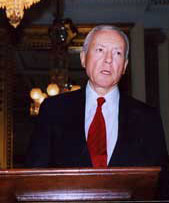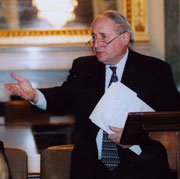Roughly two decades of NIDA-sponsored research and clinical trials have culminated in the Food and Drug Administration's (FDA) approval of buprenorphine as a treatment for opiate dependence and addiction. The medication was developed through a Cooperative Research and Development Agreement between NIDA and the firm Reckitt Benckiser, Inc.
 Senator Orrin Hatch (R-Utah), coauthor of DATA. "We are hopeful bupenorphine will be the first of many new drug addiction medications eligible for use under the Drug Abuse Treatment Act of 2000 legislation."
Senator Orrin Hatch (R-Utah), coauthor of DATA. "We are hopeful bupenorphine will be the first of many new drug addiction medications eligible for use under the Drug Abuse Treatment Act of 2000 legislation."Buprenorphine and the combination buprenorphine/naloxone are the first medications approved under the Drug Abuse Treatment Act of 2000 (DATA), which allows for office-based treatment of opiate addiction. Under the terms of DATA, physicians providing treatment must complete special training to dispense the medications, must agree to treat no more than 30 patients at a time in an office setting, and must refer patients to appropriate counseling and support services to enhance pharmacological treatment.
The FDA action will permit physicians to prescribe buprenorphine as part of office-based practice, making it possible for patients dependent on heroin or prescription painkillers such as OxyContin to receive treatment in their doctors' offices rather than requiring daily visits to a centralized methadone clinic. Patients entering or continuing treatment in clinic settings would also be eligible to receive the new medications.
The availability of an effective medication that can be provided in an office-based setting will significantly increase the number of patients receiving treatment, according to Dr. Frank Vocci, director of NIDA's Division of Treatment Research and Development. "Nearly 1 million Americans are dependent on opiates, but only 200,000 of them are getting treatment in licensed methadone clinics. Approval of this medication means that many more people who want treatment can get it," Dr. Vocci says. "FDA approval of this medication marks a truly great moment in the treatment of drug dependence and addiction, and it clearly shows the value of collaborative partnerships between legislators, Federal agencies, and private industry."
 Senator Carl Levin (D-Michigan), coauthor of DATA. "Approval of this new drug will allow for the long-awaited and appropriate conventional, office-based approach to addiction treatment in this country."
Senator Carl Levin (D-Michigan), coauthor of DATA. "Approval of this new drug will allow for the long-awaited and appropriate conventional, office-based approach to addiction treatment in this country."Buprenorphine is pharmacologically related to morphine and is a partial opioid agonist: It has the same effect on mu opiod receptors in the brain as does heroin or other opiate drugs, but it has a lower maximum effect. Buprenorphine reduces or eliminates withdrawal symptoms associated with opioid dependence but is not strong enough to produce the euphoria and sedation caused by heroin or other opiates. Increasing the dose of buprenorphine does not enhance the drug effects, however, so the medication is unlikely to be abused.
FDA approved two forms of the medication. Buprenorphine alone will be prescribed (under the trade name Subutex) for patients in the early stages of treatment. Buprenorphine combined with naloxone, an opioid antagonist, will be prescribed (as Suboxone) for long-term maintenance therapy that will allow patients to resume and maintain normal, productive lives during treatment. Combining the antagonist naloxone with buprenorphine further reduces the potential that the medication could be abused; injecting the combined formulation triggers withdrawal symptoms. Subutex and Suboxone will be provided in tablet form as take-home medications.
